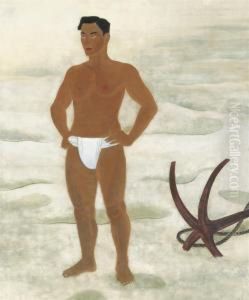Saeki Shunko Paintings
Saeki Shunko, born in 1899 in Japan, was a prominent figure in the artistic movements of the early 20th century, particularly within the realm of Japanese woodblock printing. His life, marked by both creativity and tragedy, was a reflection of the turbulent times he lived in, as well as the evolving aesthetics of Japanese art. Despite his brief career, Shunko's work left a lasting impression on the Shin-Hanga movement, a period of revitalization for the traditional woodblock printing technique known for its blend of Western and Japanese artistic sensibilities.
Shunko's artistic journey began in the cultural heart of Kyoto, where he was exposed to the rich traditions of Japanese art from a young age. The early 20th century was a period of significant change in Japan, as the country was rapidly modernizing and opening up to Western influences. This cultural shift greatly impacted the art scene, leading to the emergence of the Shin-Hanga movement, which sought to rejuvenate traditional ukiyo-e art by incorporating Western principles of realism, perspective, and shading. Shunko was among the artists who embraced these new ideas, integrating them with the classic subjects of nature, landscapes, and the beauty of everyday life.
Despite his promising start and the innovative quality of his work, Saeki Shunko's career was cut short by his untimely death in 1928, at the age of 29. His contributions to the Shin-Hanga movement, however, continued to be celebrated posthumously. Shunko's prints are characterized by their delicate beauty, meticulous craftsmanship, and a harmonious blend of traditional and modern aesthetic elements. His work captures the transient beauty of nature, a theme deeply rooted in Japanese culture, while also reflecting the new artistic trends of his time.
Shunko's legacy is a testament to the impact that emerging artists can have on the evolution of traditional art forms. His ability to adapt and innovate within the confines of the woodblock printing tradition inspires contemporary artists to explore new avenues while respecting their cultural heritage. Although his life and career were brief, Saeki Shunko's art continues to be admired for its beauty, technical skill, and unique position at the crossroads of cultural and artistic transformation in early 20th-century Japan.
